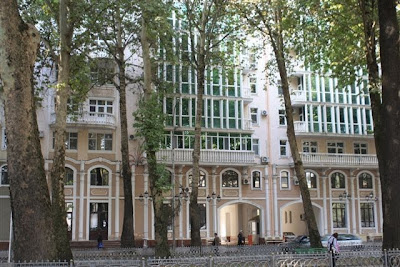I have no photos to bring this experience alive as getting a camera out at a border post or with the police around is asking for trouble, but I must try and relay to you some of the border experience we had after leaving Dushanbe to travel to Samarkand in Uzbekistan. My words will only be able to convey some of the tension (and farce) of the experience. Firstly we learnt on Friday evening that the Panjakent border with Uzbekistan had been closed. We had already booked a vehicle for the 6 hour drive over the mountains north of Dushanbe to get to that border crossing, so if we had left and driven there I do not know what we would have done! Our plane tickets were booked and paid for for departure from Tashkent at 3.50am on Tuesday morning so we would have to reach Tshkent by late Monday night. There are no flights between Dushanbe and Tashkent due to the poor Tajik/Uzbek government relations! Anyway the driver was not interested in taking us to the border crossing nearer to Dushanbe as this was only a 45 minute ride, so our landlord organised for a relative who was working at that border crossing to pick us up at 7.00am on Saturday to take us to the border. We were also to ask for another relative who worked there who would ensure our smooth passage. All seemed well and we had waited 5 days for our Uzbek visas in Dushanbe and had finally got them at 5.00pm on the Friday afternoon, so Uzbekistan and Samarkand here we come ..... or so we thought. None of us had noticed that our Tajikistan visas expired on 3rd November and this was now 6th - we were not allowed to leave the country and had broken the law! This meant a wait of about 2 hours at the border for the boss to sweep up in a large black car with blackened windows and take us off to his office with all our bags. The police would "help" us and try and get the legal process finished as quickly as possible. It normally takes about 3 or 4 days we were told and the fine can run into thousands of pounds. We couldn't tell if they were all in a bribary ring and spinning a yarn about the court that we had to attend or whether they were following proper Tajik legal process. Anyway we were told that a fine of $350 each was the absolute minimum and that if we paid them then they would try and rush through the paperwork, contact the district judge, try and keep the court open (it was Constitution Day and a public holiday) and get us away later that day. Well the form filling took about two hours, trying to find cash from three ATM's in the street was futile as they were all empty, so we offered to pay in a mixture of dollars, pounds and euros. This was acceptable so we dashed back to the police offices for more form filling, including having to sign personal statements (written in Tajik so we do not really know what they said) explaining why we had overstayed our welcome in Tajikistan. I have forgotten to explain that one of the policemen had a little English and he constantly assured us that he liked tourists, wanted to help us as far as he could and then..... wait for it .... wanted us to help him come to England to study and improve his English! Then suddenly the mood seemed to change as the Chief started smiling and reported that he had persuaded the judge to keep the court open just for us so that we could go there with the papers have the hearing and still get away. So this news was then accompanied by an invitation to join them for lunch once the process had been finished! Well after hand writing everything four times, various photocopying exercises and verification of all the papers by the chief, we were marched off through the local park to the court house. We were led into a rather scruffy back room where a large overweight lady (the judge) sat and suggested that we all sat at the table opposite her. The various police officers were allowed to stay and a clerk copied things down behind her. One by one we had to stand give our names, our addresses and explain why we were three days over our visa date. It was difficult to know whether to smile, laugh or be very deferential. The judge explained (through the one policeman who had a little English) that the Tajikistan law meant that we had to pay a fine ... we started to fear that this was more money, but it transpired that this was the $350 each we had already parted with. So we were duly dealt with sent outside to the street to wait a further 45 minutes or so whilst the paperwork was finished and then the police chief emerged with our passports and new paperwork and announcad that we would be able to leave the country! By this time 4.00pm was approaching, but still we had to go and have a lunch with them before being driven back to the border and finally getting out and across into Uzbekistan as the light faded at about 5.30pm (we had first arrived at the border at 8.00am!). This experience is the thing of late night stories suitable for telling with copius supplies of whisky. When we finally reached Samarkand at 12.45am we had to have a few to calm our nerves. The driver we hired from the border to drive us to Samarkand was a maniac and had to be told to slow down on a number of occassions. Enough of this... let's get back to some photos of wonderful Samarkand in the next post.











































